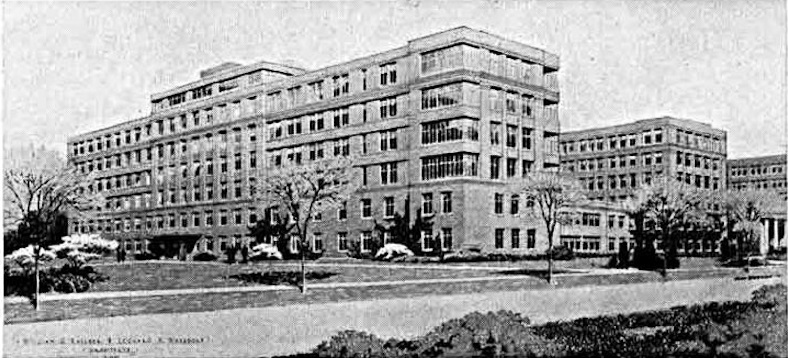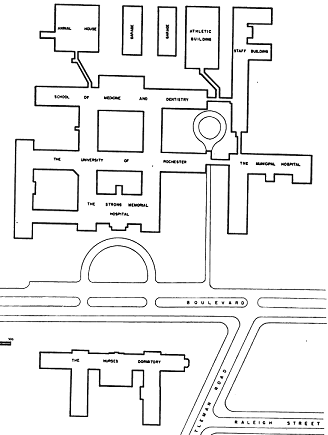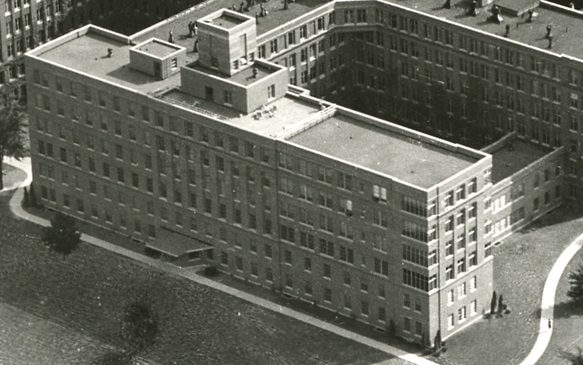
| Medical Center | Q Wing (8100) |
 |
| New Hospital Wing, from Rochester Review 18(5):22 (June-July 1940) |
 |
 |
| Plot Plan from Hospital
Planning, by Charles Butler and Addison Erdman (1946) Page 118 |
New Wing in 1941 after completion |
The first major addition to the original building was a new wing for the hospital, which opened in May 1941 to provide additional private rooms for patients. This new wing was originally called R Wing, but was renamed Q Wing when the new Psychiatric Wing was opened in 1949 as R Wing. The one-story connecting corridor between B Wing and the new wing was called M Wing in some references.
Floor plans of the new
wing are included in the 1946 floor plans of the original
building..
References
1940 "Plan
to Add Wing Bared by Hospital," Democrat and Chronicle,
January 17, 1940, Page 17. | Part
2 |
1940 "University Will Expend $400,000 To Increase Hospital Facilities," Rochester Review 18(5):22 (June-July 1940)
1940 "Hospital to Build $390,000 Addition," Democrat and Chronicle, September 2, 1940, Page 20.
1940 "Unions Move to End Strike" Democrat and Chronicle, October 26, 1940, Page 18.
1940 "Delay Denied on New Wing," Democrat and Chronicle, December 27, 1940, Page 13.
1941 Annual Report of
the President and Treasurer of the University of Rochester 1940-1941
Page 86-87: New Hospital Wing. In the report of a recent survey
in Rochester by Dr. W. G. Smillie, it was recommended that more low cost
hospital beds be provided. The new wing of Strong Memorial Hospital is
designed to meet the need of patients of moderate means who desire
privacy, and eighty per cent of the private rooms are of the minimal cost
type. The upper four floors will eventually be occupied by patients. The
ground and first floors provide much needed extension of dining room and
kitchen facilities, locker and rest rooms for employees and diagnostic and
treatment facilities for physicians. The top floor of Wing R was occupied
by patients on May 1, 1941, and the fourth floor on July 1, 1941. The
third floor provides additional housing accommodations for nurses until it
is needed for patients. The second floor of the new wing is not being
completed for hospital use at this time. The private offices, which
formerly were adjacent to the Out-Patient Department on the ground floor,
have been moved to the south end of the first floor of Wing R. This unit
comprises a waiting room, doctors' conference room, office for nurse and
secretary, laboratory, six private offices and examining rooms. The
administration offices now occupy a section of the two-story building
which connects Wing R and Wing B.
The construction of this wing under the competent direction of Kaelber and
Waasdorp, Architects, and Hopeman Brothers, Contractors, was interrupted
for five weeks in the fall of 1940 by a labor union jurisdictional
dispute. Although the demand for additional beds was great throughout the
period of construction, the restriction of a Monday-to-Friday five-day
week was observed. Hospital service in this building will be provided, as
in all hospitals, twenty-four hours a day and seven days a week.
1946 Hospital
Planning, by Charles Butler and Addison Erdman
Pages 118-128: Strong Memorial Hospital and Rochester Municipal
Hospital, including floor plans for Q Wing.
1950 The
First Quarter Century 1925-1950
Page 26: The opening of Wing Q in May, 1941, provided
additional single rooms, most of which are small but adequate for patients
who desire privacy at minimal cost.
1975 To
each his farthest star: The University of Rochester Medical
Center -1925-1975, edited by Edward C. Atwater and John
Romano.
Pages 275-276: In July of 1942 the five-year degree course had
been accelerated for the duration to enable students to complete their
work in a little over four years.
This speedup, plus the large number of cadet nurses, led to a peak
enrollment of 325 students in the spring of 1945. To accommodate everyone
an addition, financed by federal funds, was added to Helen Wood Hall to
house 33 students, and two floors in the Q Wing were converted to
dormitories.
Page 324: Not only has the type of disease problem changed in
hospitalized patients over the past thirty years, but so has the
distribution of patients by social and economic background. Formerly, ward
or division patients were isolated in the Municipal Hospital, which was
physically part of Strong Memorial Hospital with its adjacent semiprivate
two and four bedrooms and the strictly private Q Wing with single rooms
located further down the corridor to the west.
1977 History
of the University of Rochester, 1850-1962, by Arthur J.
May. Expanded edition with notes
Chapter 31, Women, Music, Medicine in Wartime
In June, 1940, construction of a Q wing at the hospital was started on the
west end of the original structure; six stories high, it was designed to
care for 120 patients in private and semi-private rooms.
© 2021 Morris A. Pierce